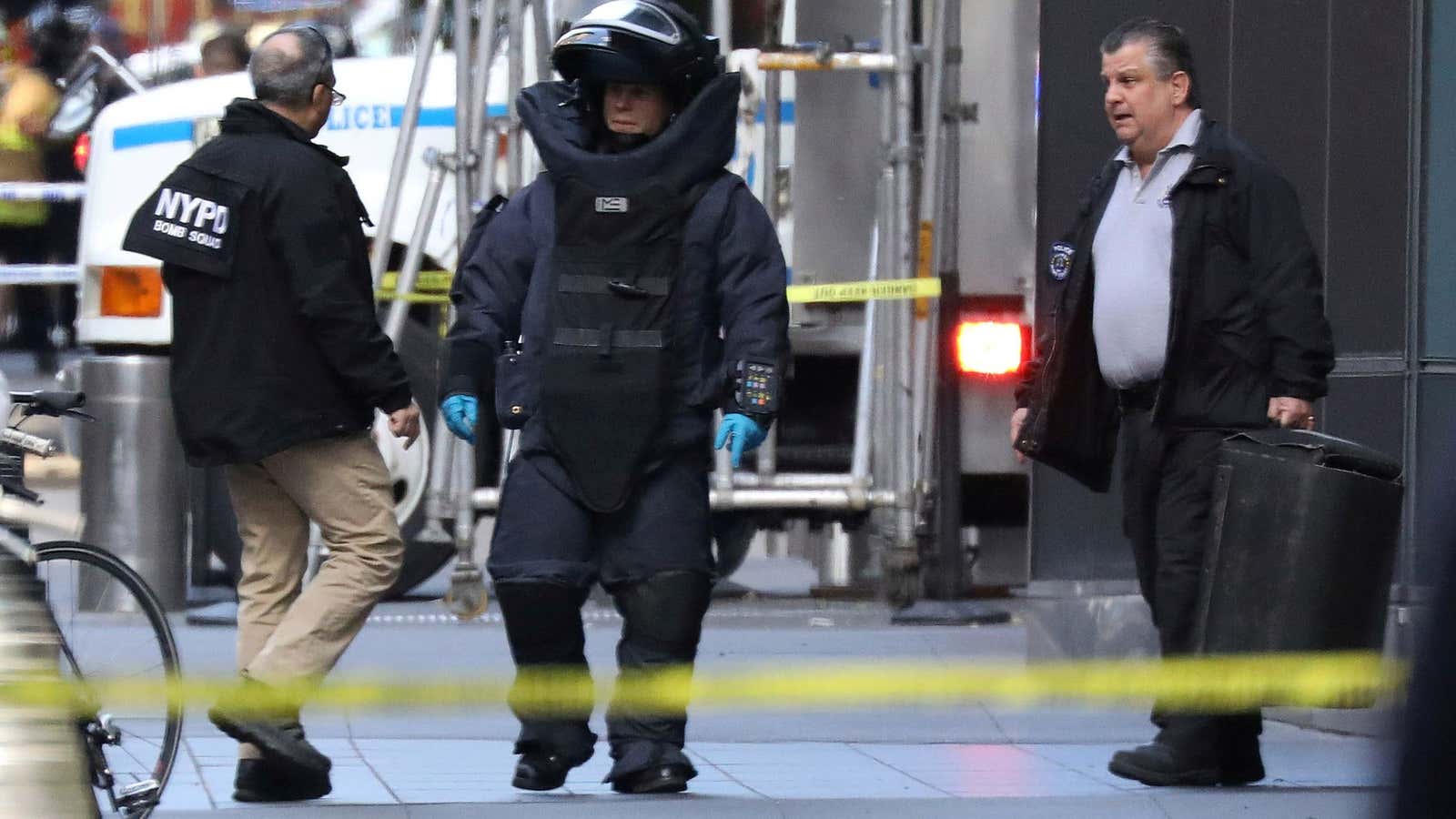Using the mail is a good way for a bomber to get caught.
The FBI says it was able to quickly identify the suspect in connection with the explosive devices sent this week to prominent critics of Donald Trump by lifting a fingerprint from one of the packages sent to California congresswoman Maxine Waters. DNA taken from two of the devices was also linked to Cesar Sayoc, the Florida man who has been charged. Investigators had also reportedly been using the US postal service’s imaging system, which photographs every piece of US mail, to zero in on the state as the launching point.
Historically, probes into serial bombings and mail attacks have often been long and difficult—and have also led to investigative innovations, for better or for worse. One of them was the postal service’s photographing system, which was devised after the deadly anthrax attacks of 2001, in which the bacteria that causes it was sent in letters.
Another development stemming from such investigations is the controversial technique of criminal profiling, which has some of its roots in the search for New York’s “Mad Bomber” of the 1940s and ’50s, a man who planted bombs by hand around the region and also sent letters that eventually helped nail down his identity.
Here are the methods, leads, and coincidences connected to other serial bombers and mail attackers:
The Mad Bomber
The TV show Mindhunter might make you believe criminal profiling started in the 1970s in an FBI basement in Virginia. In his book (and story for The Smithsonian), Michael Cannell explains how two decades earlier, exasperated detectives searching for the person who had been terrorizing New York for 16 years by placing homemade bombs in public places, turned to a psychiatrist.
Dr. James Brussel, hesitant at first, started analyzing the bomber’s modus operandi, looking at clues like handwriting and the content of the letters that were being sent to newspapers as an accompaniment. In them, the perpetrator railed against Con Edison, the local electricity company. Using Freudian theory and deduction, Brussel was able to outline the suspect’s characteristics in seemingly astonishing detail: he lived with older female relatives (because he had a complicated relationship with his mother); he wasn’t able to hold down a job and would dress in old-fashioned clothing because of his social isolation (because he was a paranoiac schizophrenic who held grudges); he was over 40 (because that’s when symptoms of the disorder worsen).
Whether or not it was Brussel’s profile that led investigators to to arrest George Metesky in 1957 is disputed—he was wrong on several points, and more important seemed a Con Edison employee discovering that the language in Metesky’s complaints against the company matched that in letters the bomber had sent. In any case, criminal profiling as an investigative technique eventually would take hold.
Despite popular cop-show narratives—and some apparent successes—profiling is not the magic solution to crime-fighting. In fact, researchers doubt it is effective at all.
The Unabomber
Ted Kaczynski’s mail bombs killed three people and injured 24 over 17 years before he was caught in 1996. What led to the capture of America’s most notorious mail bomber was his own words—35,000 of them. After he said he’d “desist from terrorism,” and the FBI agreed, The New York Times and The Washington Post published his manifesto, in which he outlined his philosophy about the dangers that technology posed to society.
His brother David read the treatise and recognized Ted’s style of writing, and reported this, along with letters and documents the troubled bomber had written to the FBI, which was able to confirm the similarities.
The Olympic Park Bomber
Over two years in the 1990s, a bomber was planting a string of explosives in the southern US. One exploded during the 1996 Atlanta Olympics, one in a gay club, and three at abortion clinics.
Right after the Olympic attack, investigators using profiling techniques had improperly targeted security guard Richard Jewell, which turned out to be a tragic mistake.
Eric Rudolph was seen leaving the site of one of the clinics, but for five years, he evaded law enforcement by hiding out in the woods. He was captured by total coincidence. One day he ventured to a supermarket in rural North Carolina and was scrounging for food in a dumpster when he was noticed by a local policeman and arrested for attempted burglary.
The Austin Bomber
Earlier this year, residents of Austin, Texas, were terrorized by a package-bomb campaign that killed two people. According to The Statesman, investigators were able to find the perpetrator through a combination of basic police work and sophisticated technology (even a spy plane was used).
Mark Conditt was among a pool of suspects after investigators looked through retail receipts at hardware and big-box stores for components used to make the bombs. They were able to trace one of the packages to a specific FedEx location, where they identified him from surveillance videos. Cellphone tracking and the suspect’s increasingly reckless phone use led them to his exact whereabouts.
He detonated his last bomb as authorities were closing in, killing himself.
Anthrax attacks
The deadly series of anthrax mail attacks carried out in 2001 would result in an exhaustive and expensive FBI investigation but no certainty on the killer.
Five people in several cities died, and despite more than 9,000 interviews, no one was charged and convicted. One man was wrongly accused, and another, the FBI’s main suspect, committed suicide before any important questions were answered. Maintaining they has identified the culprit, the FBI closed its investigation, although many doubts were cast on its conclusions since (read Wired for a full account).
The investigation led to two important outcomes. One was the development of “microbial forensics,” an investigative method that includes genome sequencing. It also led the postal service to institute a system in which every piece of mail sent in the the country would be photographed and catalogued, which has been used by investigators in the latest mail bomb scare.
